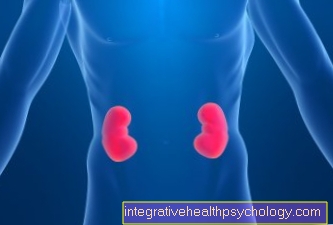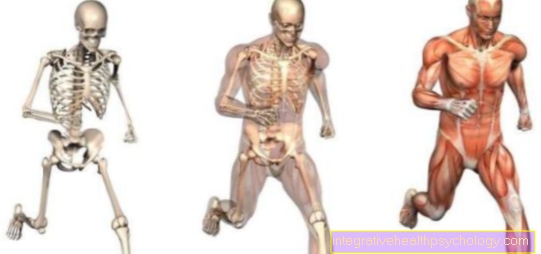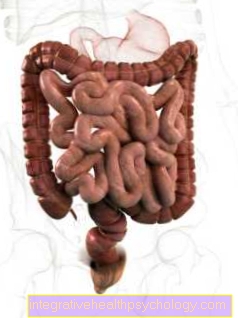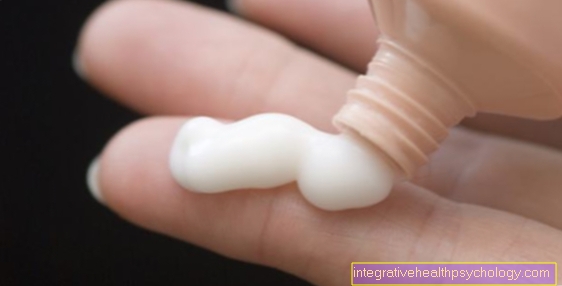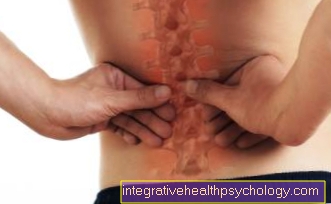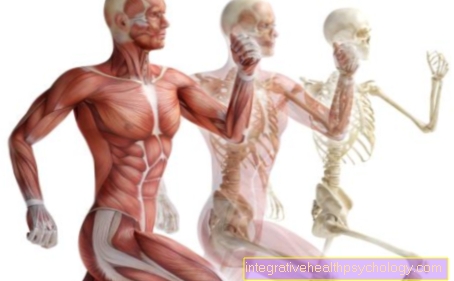Cramps in the abdomen
introduction
Abdominal cramps can have a variety of causes. Mostly these are harmless, but in some cases serious and even life-threatening illnesses can be behind the pain. Cramps are caused by the contraction of so-called smooth muscles, which, unlike striated skeletal muscles, can be found in the wall of hollow organs such as the gastrointestinal tract, the urinary bladder and the internal female genital organs such as the uterus and fallopian tubes.
General information about abdominal cramps can be found at: Cramps in the abdomen

Causes of cramps in the abdomen
Triggers such as inflammation, foreign bodies, and injuries can trigger painful smooth muscle contractions.
The pain of a visceral spasm, the so-called colic pain, occurs characteristically suddenly and with great intensity, then slowly subsides until it is almost completely pain-free, and then occurs again. A classic example of spasmodic bowel pain is biliary colic. Triggered by inflammation of the gallbladder or foreign bodies such as gallstones, the smooth muscle wall of the gallbladder contracts, causing severe pain in the right upper abdomen.
Read more on the topic Gallbladder pain.
Cramps also occur when increased gastrointestinal activity is desired. This is e.g. the case with poisoning, when the body wants to get rid of the toxic substance as quickly as possible, or with food intolerance. In the case of so-called food poisoning, the toxins of the pathogens (for example bacterial toxins) still play an important role: they draw water into the interior of the intestine and provoke increased intestinal activity. The last-mentioned causes are acute symptoms that cease by themselves.
Persistent cramps in combination with diarrhea are an indication of inflammatory bowel disease: Crohn's disease and ulcerative colitis. The exact mechanism by which diarrhea and cramps occur in these two diseases is not exactly known. What they have in common, however, is that they show injuries and inflammatory changes in the intestinal mucosa. Here, too, the mechanism of irritation is probably essential for the increased intestinal activity.
In addition to the intestine, other organs can be responsible for cramps in the abdomen: the urinary and sexual organs. In women in particular, cramps in the abdomen are an absolute frequency as part of their monthly menstrual period. Far from menstruation, cramps and cramp-like pain can also be inflammation of the fallopian tubes, uterus and urinary bladder. In particular, if pregnancy is possible, pregnancy complications or an ectopic pregnancy must be ruled out. Kidney and urinary stones, for example, are less common with cramps and more with colicky abdominal pain.
Location: left, right, center
In addition to the pain characteristics, the localization of the pain can also provide clues as to its cause.
Left abdominal pain
Pain in the lower abdomen on the left side, for example, can indicate inflammation of a protrusion in the wall of the large intestine called a diverticulum. In this case, one speaks of diverticulitis, which particularly often affects the part of the large intestine located in the left lower abdomen. The disease, which mostly affects elderly patients, is favored by low-fiber diet and constipation and can lead to perforation of the protuberance with serious consequences.
Right abdominal pain
Right-sided abdominal pain is often the leading symptom of appendicitis. Strictly speaking, the disease is not the inflammation of the appendix itself, but the inflammation of the appendix, an appendix of the large intestine which is 15 cm long on average and which contains lymphatic tissue and is a remnant of the physical development history of humans. The symptoms of visual bowel inflammation usually arise unspecifically in the middle abdomen and then increasingly concentrate on the right lower abdomen. In both clinical pictures, diverticulitis with left-sided abdominal pain and appendicitis with right-sided abdominal pain, the spasmodic pain character is not in the foreground, but a corresponding diagnosis is usually appropriate in the case of unilateral pain.
Unilateral abdominal pain
Since the ovaries and fallopian tubes are paired, diseases of these organs can cause discomfort on both sides. Ovarian cysts and ovarian tumors are possible causes of unilateral abdominal pain in women. These do not necessarily cause cramp-like pain, but should be ruled out with a thorough examination if suspected. Unilateral, cramp-like abdominal pain in women can cause so-called endometriosis or ectopic pregnancy, which is feared due to its bleeding complications.
Endometriosis is the presence of uterine lining outside the uterus. Mostly this is found near the internal female genital organs in the small pelvis. There it causes, among other things, cycle-dependent unilateral or bilateral, mostly cramp-like pain. In two to eight percent of cases, the misplaced uterine lining is found in the fallopian tubes, where it leads to painful contractions of the smooth muscles.
Another cause of unilateral abdominal pain in women can be the so-called middle or intermenstrual pain. It can occur one to two days before ovulation or as a result of the follicle rupture.
If sexually active women of sexually mature age suddenly experience severe unilateral abdominal cramps, an ectopic pregnancy must be considered and clarified with ultrasound diagnostics. In this form of pregnancy, the fertilized egg implantes outside the uterus in one of the two fallopian tubes. During the subsequent cell division, the embryo increases in volume, which stretches the walls of the fallopian tube. Unilateral or bilateral pain and intermenstrual bleeding can occur. Due to the unfavorable supply situation for the embryo, the pregnancy is terminated in many cases. If this does not happen, however, further embryonic growth can tear the fallopian tube wall. The heavy bleeding that occurs is acutely life-threatening and requires immediate surgical intervention.
Get more information about the Ectopic pregnancy.
Intestines
Intestinal disorders are a common cause of abdominal cramps. Like all hollow organs, the wall of the intestine is made up of smooth muscles that can have painful contractions.
Infectious gastrointestinal diseases
Most people are familiar with intestinal cramps caused by infectious gastrointestinal inflammation. This disease, popularly known as gastrointestinal flu, is associated with nausea, vomiting, diarrhea and pain. The abdominal cramps that it causes usually improve after a bowel movement and then reappear after the symptom-free phase.
Infectious gastrointestinal diseases are usually triggered by viruses such as noro- or rotaviruses or bacteria such as Salmonella, Campylobacter, Shigella or certain E-coli species. Transmission usually takes place from person to person via fecal-oral infection with poor hand hygiene. Transmission through contaminated food is also conceivable and occurs primarily with Salmonella and Campylobacter, but also with noroviruses.
Due to the presence of symptoms such as nausea, vomiting, fever and diarrhea as well as the mostly acute but short course, infectious causes can usually be determined through observation and anamnesis without further diagnosis.
Chronic Inflammatory Bowel Disease
If cramps in the abdomen combined with diarrhea, fatigue and weight loss occur frequently and in spurts, a chronic inflammatory bowel disease such as Crohn's disease or ulcerative colitis should be considered. In contrast to the infectious causes, no pathogens can be identified here as triggers of the inflammatory changes. The origin of Crohn's disease and ulcerative colitis has not yet been conclusively clarified, but an autoimmunological cause is being discussed in both cases.
The frequent occurrence of diarrhea and cramp-like pain are rather unspecific signs, but younger patients with chronic complaints in particular should be checked for the existence of a chronic inflammatory bowel disease. In addition to weight loss and deficiency symptoms, warning signs include bloody stools in ulcerative colitis and anal fistulas in Crohn's disease.
Symptomatic treatment is possible in both cases and is carried out according to the stage according to the severity of the symptoms.
Irritable bowel syndrome
Irritable bowel syndrome is a common disease from which almost every second patient with gastrointestinal complaints suffers. No organic reasons can be found as triggers of the symptoms, which is why one speaks of an exclusion diagnosis, which can be made after a thorough, inconclusive investigation and exclusion of other causes.
Irritable bowel syndrome mainly affects women. The symptoms mainly consist of diffuse abdominal pain, which can affect the entire abdomen, cramps in the abdomen, diarrhea, constipation and an urge to defecate. The symptoms usually improve after defecation. Here, too, no cause could be identified. One suspects a nervous overreaction of the intestine to various factors. This explains, for example, that irritable bowel syndrome is aggravated by stress and psychological tension. The focus of the therapy is on medical education of the patient about the harmlessness of the disease, autogenic training, nutritional advice and the administration of antispasmodic medication in the event of pain.
Flatulence
On average, humans produce around 1.5 liters of intestinal gases per day, which are either excreted through the anus or absorbed by the intestinal wall. Intestinal gas production can be massively increased through the consumption of flatulent foods such as legumes, onions, certain nuts or types of cabbage. If the excretion is restricted, the smooth muscles of the intestine stretch and thus intestinal cramps. In most cases, flatulence, also called meteorism in medical terminology, is harmless. So-called trapped winds, which are caused by the trapping of intestinal gases in a section of the intestine, can cause considerable discomfort. The intestinal passage can be restricted by adhesions after operations, by kinking the intestine itself or by tumors. It should be clarified by imaging diagnostics.
In the majority of cases, abdominal cramps caused by flatulence are enough to avoid flatulent foods and, if necessary, to use a defoamer such as simeticon. Intestinal gases are mostly present in the intestinal convolutions as foam from gas and chyme or stool and can be poorly absorbed or excreted through the intestinal wall. A well-known home remedy for flatulence is caraway, which can be taken straight or as a tea.
bladder
Bladder and urinary tract diseases can also cause cramps in the abdomen. As in other hollow organs, smooth muscles are also found here. The urinary bladder has a maximum capacity of 400 ml of liquid and is located in the area of the small pelvis. It is the reservoir for the urine continuously produced by the kidneys. In women in particular, urinary tract infections can occur due to the anatomical conditions such as a shorter urethra compared to men and their proximity to the anal area. Most common here is the so-called bladder infection or cystitis. The most common pathogens of cystitis are faecal germs such as E-coli, which rise through the urethra and can cause painful inflammation of the urinary bladder lining. In addition to the female gender, factors such as the existence of an immune deficiency or diabetes mellitus increase the likelihood of developing a cystitis.
Symptoms are a painful urge to urinate, painful emptying of the bladder and cramp-like pain in the lower abdomen, as well as the discharge of bloody urine. A bladder infection should be treated in good time, if necessary also with antibiotics, to prevent the disease from spreading to the ureters and the renal pelvis. In the case of inflammation of the renal pelvis or ureters, severe back pain and sometimes high fever and fatigue are possible.
A non-infectious cause of abdominal cramps caused by the bladder is urethral syndrome. The symptoms are similar to those of a bladder infection, but no inflammation can be identified as the cause of the symptoms during the diagnostic work-up. The origin of the disease has not yet been conclusively clarified, but one suspects a constant tendency to cramp in the smooth muscles as a result of multiple infections or changes in the hormonal balance of women after menopause. After a thorough investigation of any inflammatory causes that require antibiotic therapy, the treatment usually consists of pelvic floor training and a lifestyle change with a view to reducing stress.
You might also be interested in: Urinary tract infection
pregnancy
During pregnancy are abdominal cramps and cramps of the abdomen not infrequently. In most cases, they are harmless and are caused by the increasing stress on internal organs, and des Connective tissue of the ligament and pelvic floor apparatus caused. Spasmodic discomfort can also through sexual intercourse and one orgasm to be triggered. The normally pleasant uterine contractions during orgasm can turn into painful but harmless cramps that have a labor-like character during pregnancy.
Recurring abdominal cramps in pregnancy can addressed to the gynecologist and clarified become. Occasionally they will go through benign growths of the uterine muscles, through so-called Fibroids, caused. These can cause increasing symptoms as the child grows, but often do not require any therapy.
Occur in addition to the cramps Bleeding or discharge on, must urgently consulted a doctor become. It an abortion threatenswhich unfortunately often occurs in the first twelve weeks after conception. At advanced pregnancy announce cramps and the discharge of mucus or even amniotic fluid possibly a premature birth on. The doctor must decide whether the pregnancy should be carried to term or artificially extended.
If you also have foul-smelling discharge, fever and chills, an infection should be considered. In this case, too, it is essential to consult a gynecologist in order to prevent harm to mother and child as far as possible.
Duration of the cramps
The duration of cramps generally depends on their cause.
The example of food poisoning can be an entertaining experience, as the cramps are only required once for a very fast passage of food through the gastrointestinal tract. In the case of inflammatory bowel diseases, cramps, as the term "chronic" already suggests, are permanent and very stressful for those affected. With other causes, for example parasites or food allergies, the cramps, including diarrhea, persist for as long as the causative mechanism exists. If the pelvic pain persists for more than a few days during menstruation in women, it may be endometriosis. These cramps can also become chronic, i.e. persist.
In general, long-lasting cramps should always be clarified by a doctor.
Concomitant symptoms
The most common symptom of cramps are accompanying diarrhea and not infrequently pain or an uncomfortable pulling in the abdominal area. Depending on the cause, different and unspecific symptoms can occur. In the case of chronic inflammatory bowel diseases, in addition to sometimes bloody diarrhea, abscesses, fistulas and symptoms in other organs can also occur. The persistent inflammation can cause anemia (anemia) and side symptoms such as fatigue, depression and irritability. If the cramps cause diarrhea and, in turn, deficiency syndromes, typical symptoms of vitamin and nutrient deficiency appear.
This is how to treat cramps in the abdomen
In general, it is important to find the cause of the cramps and to treat them appropriately. The cramps themselves can then be treated symptomatically, for example with medication such as metamizole, which primarily has a pain-relieving effect and also has an antispasmodic effect. A stronger drug for cramps, but not pain, is butylscopalamine. It belongs to the group of so-called spasmolytics (antispasmodics).
Common home remedies for cramps in the abdomen are warming moist compresses, healing clay, or cherry stone pillows, as these calm the intestinal muscles through a complex reaction of the nerves in the abdominal skin. Diet adjustments should also always be considered. It is advisable to eat easily digestible food, which should also be constipating if you have diarrhea. In the case of cramps caused by menstrual cramps, it is advisable to drink women's mantle tea.
Learn how to Fight cramps can.
Or read our article on the question: What works best against intestinal cramps?

